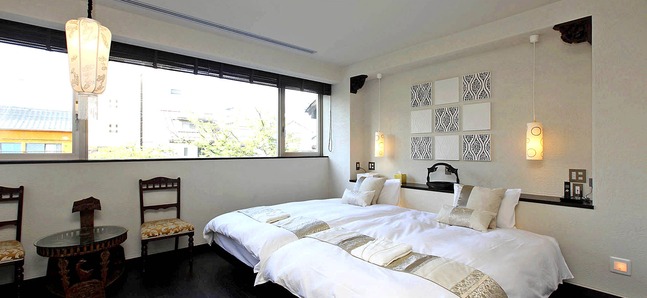
Posted: Fri Sep 25 2009
Where else in the world can you choose between staying in a modern hotel, a classic inn, a converted townhouse, an old storehouse, a Buddhist temple, an imperial villa or a budget hostel? Accommodation in Kyoto can mean sharing a tatami mat floor with half a dozen strangers, or encountering hospitality as an art form.
Your first decision is whether or not to make the accommodation integral to the experience. If you want a concierge, a spa and a bar, stick to the hotels. Kyoto has some impressive options, with the Hyatt Regency, Granvia and Westin Miyako standing out: for service, style and comfort, these three are hard to fault.
There is a quartet of top-class boutique hotels: The Screen, which attracted a blaze of attention when it opened in 2008; the Chourakukan Hotel, which opened later the same year but far more quietly; the Hotel Mume, which arrived in mid 2009; and the Prinz Apartotel, whose two rooms make it a boutique, though perhaps not quite a hotel.
For those that want to live, breathe, eat and sleep Kyoto, a stay at one of the many ryokan is a must. These traditional inns exist throughout Japan, but nowhere else will you find such a high standard of hospitality. At the best establishments there will be a short curtain to welcome you, not a door to block you. The stone entrance will have been freshly sprayed with water, telling guests that everything is in order. When you enter your room, you may find the lingering hint of an incense stick lit hours before your arrival. Such is the precision of ryokan hospitality.
The rooms are sparingly furnished. The decor will usually be composed of calligraphy and freshly cut flowers. The furniture is just a low table and perhaps a lacquered chest, whereas the bedding, a futon, is rolled out by the maid each night.
These aren't just places to slumber. The high-end ryokan experience involves a kaiseki meal delivered to your room, a soak in a wooden bathtub, and lounging in a yukata gown, absorbing the garden. Some orthodox ryokan operate just as they did a century or more ago; others are keeping pace with progress, while retaining the essence of Japanese hospitality. Needless to say, the ones with a contemporary outlook are the most comfortable, which is just as well because some of the more conservative places don't welcome foreigners. The ryokan listed here all cater to international visitors.
For the Old Kyoto atmosphere without the fine dining and fastidious service, there are classic townhouses (machiya) for private rental. At the very top end are the Iori establishments, decked out in fine arts and luxury furnishings. For those on a tighter budget, there are a number of machiya now operating as hostels. Though atmospheric and great value, they don't always stand up well to the elements. In the humid summer months, you would be wise to avoid the cheapest Japanese-style dorms.
Curfews
Some of the more economical ryokan and guesthouses impose curfews, usually from around 11pm. Others lock the doors but provide guests with access codes or keys. The pricier places rarely have such rules, but in a ryokan, with their wooden floors and thin walls, make sure that to return to your room quietly.
Location
For peace and quiet but easy access to the wonderful sights, anywhere in Higashiyama is a good choice to stay. If you're planning to do plenty of temple-hopping, pick a place near Kyoto station, with easy access to all train and bus routes. Downtown and Gosho district accommodation will suit anyone who likes their cities served straight up. Even though the North-west is a little far from the action, it's worth considering a night or two here as a base for exploring this endearing district and its legendary temples.
Prices
Be careful when comparing room rates. Though prices for deluxe hotels and ryokan are comparable, the hotels are charging per room, while the ryokan rate is usually per person. Some offer reduced rates if you don't wish to have the evening meal. The deluxe price bracket here (¥¥¥¥) assumes a regular night with full dinner. Expect to pay ¥40,000-¥90,000 per person per night. At the other end of the spectrum, a futon in a dormitory can cost as little as ¥2,500.
Booking ahead
If you wish to see the cherry blossom, autumn leaves, Gion Festival or New Year celebrations, book at least three months ahead and expect to pay up to double the off-peak rates. If visiting off-peak (after New Year until the end of February, and in June), you may find a few of the fancier establishments become surprisingly affordable.
Tweets
- About Us |
- Work for Time Out |
- Send us info |
- Advertising |
- Mobile edition |
- Terms & Conditions |
- Privacy policy |
- Contact Us
Copyright © 2014 Time Out Tokyo



Add your comment